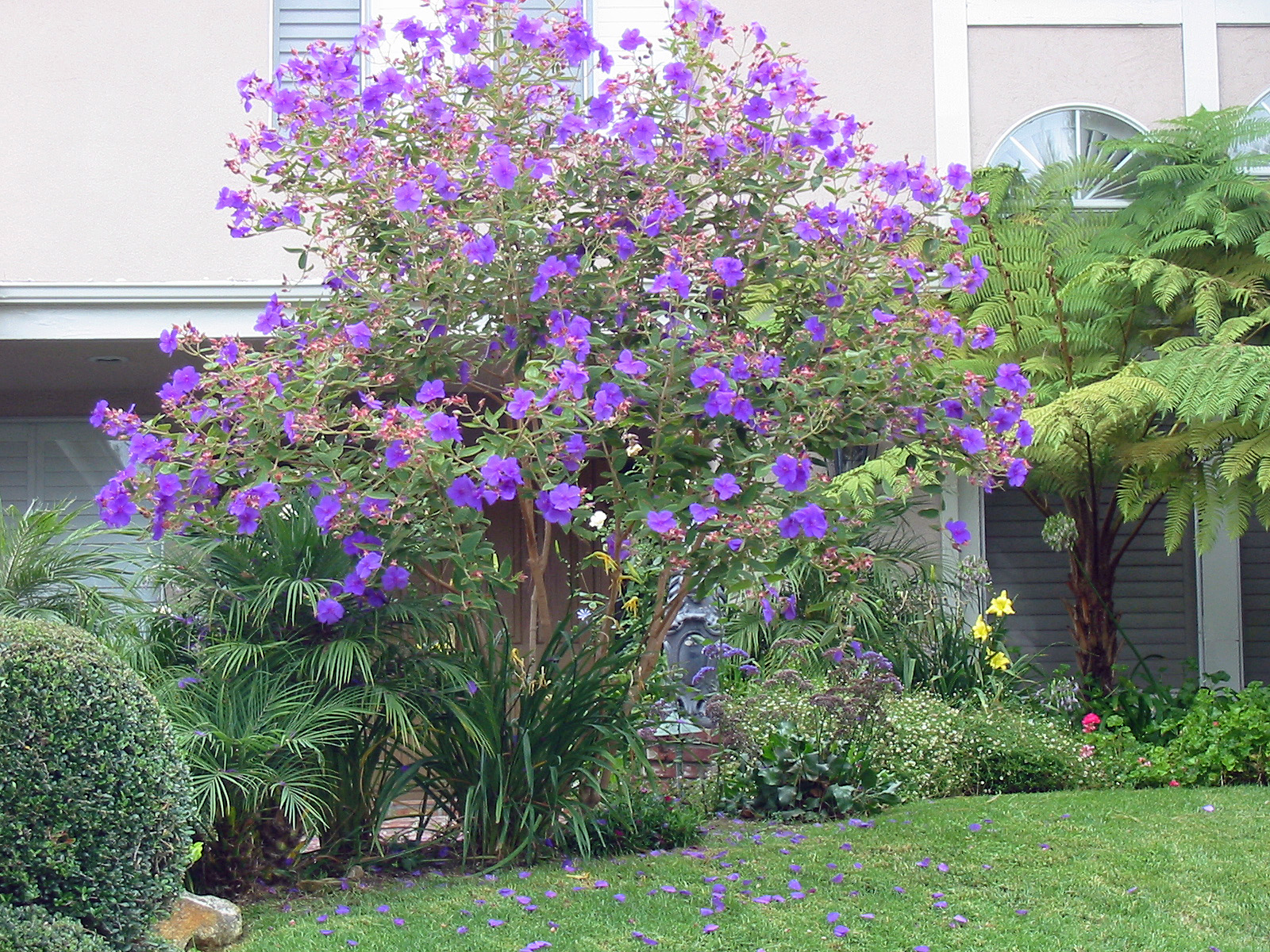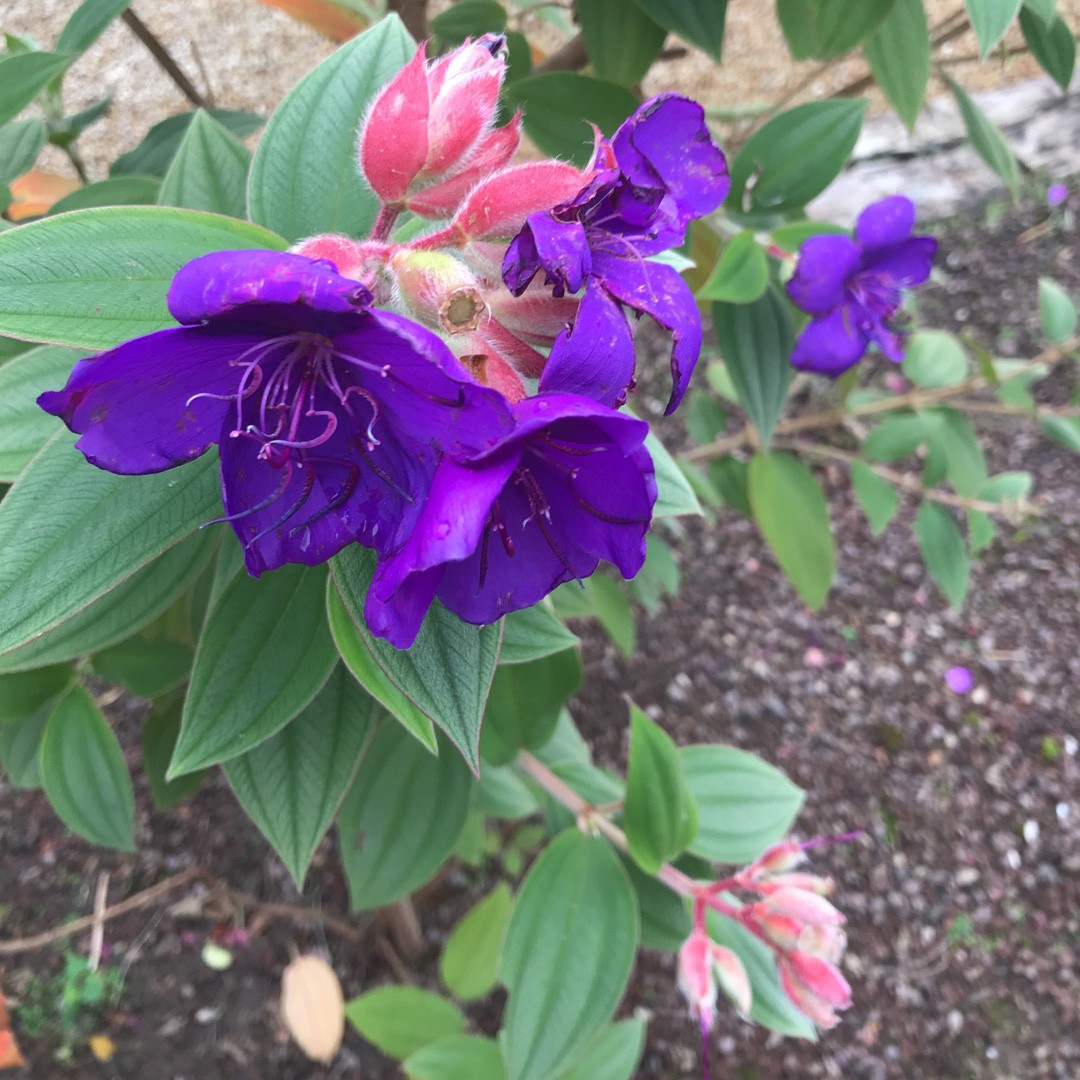Growing Princess Flower
Tibouchina Urvilleana
A complete guide to cultivating this stunning tropical beauty with vibrant purple blooms
Meet the Princess Flower
Native to Brazil, Princess Flower (Tibouchina Urvilleana) is a glorious addition to tropical and sub-tropical gardens. This award-winning evergreen shrub features stunning purple blooms and velvety foliage, making it a standout landscape feature.
Common Names
Princess Flower, Glory Bush, Purple Glory Bush, Lasiandra
Origin
Native to Brazil
USDA Zones
9-11 (Can be grown in Zone 8 with winter protection)
Mature Size
6-8 ft tall (up to 15 ft in ideal conditions)
Quick Plant Facts
Plant Type
Broadleaf evergreen shrub or small tree with a rounded or vase-shaped growth habit
Light Requirements
Full sun (with afternoon shade in hottest zones)
Water Needs
Regular watering; moist but well-drained soil
Soil Preference
Rich, slightly acidic soil with good drainage
Temperature
Tropical; cannot tolerate frost
Bloom Time
Year-round in tropical areas, with heaviest flowering from late spring through fall
Planting Guide
Location & Timing
- Best time to plant: Spring, after all danger of frost has passed
- Sunlight: Plant in full sun to partial shade (afternoon shade in hottest regions)
- Spacing: Allow 3-5 feet between plants to accommodate mature spread
- Protection: Choose a location protected from strong winds
- Containers: Excellent choice for container growing in colder regions (can be moved indoors for winter)
Soil Preparation
- Use rich, fertile soil with excellent drainage
- Amend garden soil with compost or well-rotted manure
- Ensure slightly acidic pH (5.5-6.5)
- For container planting, use a quality potting mix formulated for acid-loving plants
Planting Steps
- Dig a hole twice as wide as the root ball and equal in depth
- Remove the plant from its container and gently loosen the roots
- Place the plant in the hole with the top of the root ball level with the soil surface
- Backfill with soil, firming gently to remove air pockets
- Water thoroughly after planting
- Apply a 2-3 inch layer of mulch around the base, keeping it a few inches away from the stem
Care Guide
Watering
- Keep soil consistently moist but not soggy
- Water deeply once a week (about 1 inch of water)
- Increase frequency during hot, dry periods
- Reduce watering slightly in winter
- Avoid overhead watering to prevent fungal issues
Light & Temperature
- Full sun for best flowering (6+ hours daily)
- Afternoon shade in hot climates (zones 9-11)
- Cannot tolerate frost or freezing temperatures
- Move container plants indoors when temperatures drop below 45°F (7°C)
Fertilizing
- Fertilize 3 times yearly (spring, summer, fall)
- Use fertilizer formulated for acid-loving plants (azalea/rhododendron food)
- Apply compost or well-rotted manure annually
- Reduce or eliminate fertilizer in winter
Pruning
Princess Flower responds well to pruning, which can help maintain size and shape without sacrificing blooms.
- Prune in early spring before new growth begins
- Remove dead, damaged, or crossing branches first
- Trim to maintain desired shape and size
- Pinch growing tips to encourage bushier growth
- Deadhead spent blooms to encourage more flowering
Mulching & Protection
- Apply 2-3 inches of organic mulch around the base
- Keep mulch a few inches away from the stem to prevent rot
- Refresh mulch annually in spring
- In zone 8, provide winter protection with frost cloth
- For container plants, move indoors before first frost
Propagation Methods
Stem Cuttings
The most reliable method for propagating Princess Flower is through softwood or semi-hardwood stem cuttings.
- Take 4-6 inch cuttings in spring or early summer
- Select healthy stems with no flowers
- Cut just below a leaf node
- Remove leaves from the bottom half of the cutting
- Dip the cut end in rooting hormone
- Plant in a container with well-draining propagation mix
- Keep soil consistently moist but not wet
- Cover with plastic to maintain humidity
- Place in bright, indirect light
- Roots should develop in 4-8 weeks
- Transplant once rooted and showing new growth

Growing from Seeds
Growing Princess Flower from seeds is possible but less common than cuttings.
- Collect seeds from the small brown capsules after flowering
- Store seeds in a paper bag in the refrigerator
- Plant seeds in spring in seed starting mix
- Cover seeds lightly with soil
- Keep soil consistently moist
- Maintain temperatures of 70-75°F (21-24°C)
- Expect germination in 2-4 weeks
- Transplant seedlings when they have 2-3 sets of true leaves
Seeds may not produce plants identical to the parent.
Container Growing
Growing Princess Flower in containers is an excellent option, especially in colder regions.
- Choose a large container (at least 16-18 inches in diameter)
- Ensure the container has drainage holes
- Use a quality potting mix for acid-loving plants
- Repot every 2-3 years or when it becomes root-bound
- Move indoors before first frost in colder regions
- Place near a sunny window while indoors
- Reduce watering slightly during winter months
Seasonal Care Guide
Spring & Summer Care
Spring (March-May)
- Prune to shape and remove winter damage
- Apply first fertilizer application
- Refresh mulch layer
- Move container plants outdoors after last frost
- Take cuttings for propagation
Summer (June-August)
- Monitor water needs closely, especially during heat waves
- Apply second fertilizer application
- Deadhead regularly to encourage more blooms
- Watch for pests like aphids and mealybugs
Fall & Winter Care
Fall (September-November)
- Apply final fertilizer application
- Reduce watering as temperatures cool
- Prepare to move container plants indoors
- Check for pests before bringing indoors
Winter (December-February)
- Protect outdoor plants from frost (zones 8-9)
- Reduce watering for indoor plants
- Place indoor plants in a bright, cool location
- Monitor for pests like spider mites in dry indoor conditions
- Withhold fertilizer until spring
Troubleshooting Common Issues
Pests & Diseases
While generally pest-resistant, Princess Flower can occasionally face certain issues. Early detection and treatment are key.
:max_bytes(150000):strip_icc()/princess-flower-growing-profile-3269233-02-e0e730285d274d7bb16ac40cb2728c57.jpg)
Common Pests
Aphids
Small, soft-bodied insects that cluster on new growth
Solution:
Spray with insecticidal soap or neem oil. Introduce beneficial insects like ladybugs.
Mealybugs
White, cottony clusters on stems and leaf joints
Solution:
Remove with cotton swab dipped in alcohol. Treat with insecticidal soap or horticultural oil.
Spider Mites
Tiny pests that cause stippled, yellowing leaves and fine webbing
Solution:
Increase humidity and spray with water. Apply insecticidal soap or neem oil.
Common Diseases
Root Rot
Caused by overwatering or poor drainage; leads to wilting despite wet soil
Solution:
Improve drainage, reduce watering. For severe cases, unpot, trim affected roots, and repot in fresh soil.
Powdery Mildew
White powdery substance on leaves
Solution:
Improve air circulation. Apply fungicide specifically for powdery mildew.
Leaf Spot
Brown or black spots on leaves
Solution:
Remove affected leaves. Avoid overhead watering. Apply copper-based fungicide.
Common Growing Problems & Solutions
| Problem | Possible Causes | Solution |
|---|---|---|
| Plant Not Flowering |
|
Move to a sunnier location. Use a fertilizer with higher phosphorus content to encourage blooming. Deadhead regularly. |
| Yellowing Leaves |
|
Adjust watering schedule. Ensure good drainage. Apply appropriate fertilizer. Check for root problems. |
| Leaf Drop |
|
Maintain consistent temperature. Water appropriately. Increase humidity for indoor plants with a tray of pebbles and water. |
| Leggy Growth |
|
Provide more sunlight. Prune regularly to encourage bushier growth. Pinch tips of new growth. |
| Frost Damage |
|
Prune away damaged parts. Protect with frost cloth. For container plants, move indoors before frost. |
Landscape Uses

Specimen Plant
With its vibrant purple blooms and attractive foliage, Princess Flower makes an outstanding focal point in garden designs.
Hedges & Screens
When planted in a row, Princess Flower creates a stunning flowering hedge or privacy screen with year-round interest.

Container Gardening
Perfect for patios, decks, and entryways in containers where it can be moved indoors during cold weather.
Wildlife Benefits
- Attracts butterflies with nectar-rich blooms
- Draws hummingbirds to the garden
- Supports pollinators like bees
Companion Plants
These plants pair beautifully with Princess Flower in tropical and subtropical gardens:
- Bird of Paradise (Strelitzia reginae)
- Jasmine (Jasminum species)
- Variegated Ginger (Alpinia zerumbet)
- Bougainvillea (Bougainvillea glabra)
- Plumbago (Plumbago auriculata)
Expert Tips & Final Advice
For Success With Princess Flower
- In colder regions, grow in containers that can be moved indoors for winter.
- Deadhead regularly to encourage continuous flowering.
- Mulch well to retain moisture and suppress weeds.
- Pinch back new growth to encourage a bushier habit.
- Be patient if growing from cuttings—roots may take several weeks to develop.
Important Considerations
Invasive Potential
Princess Flower has invasive potential in certain areas, notably Hawaii. Check local regulations before planting. In areas of concern, container growing is recommended to prevent spread.
Cold Sensitivity
This plant is extremely sensitive to cold and will not survive freezing temperatures. In zone 8, it may die back to the ground but can resprout in spring. In zones below 8, it must be grown as a container plant and brought indoors for winter.





